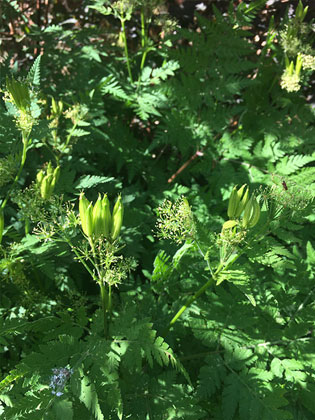
- Perennial green leaf
- Herb
- Food forest
- Bees and butterflies
- Edible flowers
- Edimentals
- Medicinal
Sweet Cicely
Myrrhis odorata
An aromatic perennial with edible, ferny, aniseed tasting leaves making it an attractive “edimental”. Popular with pollinators.
PLANT TYPE Herb
PLANT HABIT Perennial
USES Culinary, Medicinal, Pollinators, Ornamental
DESCRIPTION
An aromatic perennial with edible, ferny leaves making it an attractive “edimental”. In Spring has white flowers which are formed in large umbels popular with pollinators.
The soft textured leaves have an aniseed flavour good for use in vegetable and fruit salads or dips. They can also be cooked into soups, stews, omelettes. The natural sweetness of the leaves has been used to reduce sugar in recipes, especially when stewing tart fruits, traditionally being used to flavour rhubarb recipes as the seasons of both plants are relatively parallel. The sweet aromatics of sweet cicely also readily transfer into liquids. Leaves, stems, flowers and seeds can be steeped in vodka for a few weeks to make an anise schnapps. Sweet Cicely’s seed pods are the best treats of all, being true to life little aniseed lollies you can pick straight out of the garden.
Boiled roots of this plant are said to have medicinal qualities. Sweet cicely is also said to relieve flatulence.
Likes dappled shade of a forest garden and moist but well drained soil. It’s preference for some shade makes it an excellent food forest plant.
Other common names: Myrrh, British myrrh, Garden myrrh, Great chervil, Sweet bracken, Sweet chervil, Sweet fern, Sweet mary.
2-5 years to maturity.
RECOMMENDED LOCATION Pot, Kitchen garden, Forest garden, Wildlife garden, Ornamental garden
Aspect Partial sun, Shade, Moist shade, Moist partial shade
Height 1-1.5m
Spread 0.5-1m
Hardiness Hardy to -29°C
Management and care Seeds are best planted in the Autumn as they require a period of cold in order to germinate.
Origin/history
Sweet Cicely is found in hedgerows, on byways and field margins and on river banks in the Northern British Isles.
Quite common in Northern England and Scotland and fairly scarce in Southern England. There are purportedly areas of North-east Scotland where sweet cicely vies with cow parsley as the dominant roadside umbellifer.
Whilst native to British Isles, it is now widespread throughout Europe and is even found in Chile.
